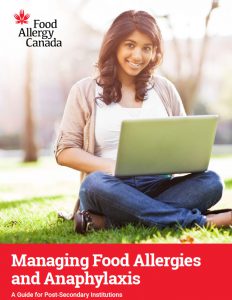Call to action: protecting people with allergies
Concerned about food allergy? It can be deadly and is something we all need to be more aware of. Students with food allergies are particularly vulnerable as they start college or university because of the big transition to more independent eating and living.
Food Allergy Canada just released a reference guide focusing on the challenges and recommended best practices for managing food allergies in post-secondary institutions. Protecting people with food allergies is a big responsibility in every food environment.
In our work as dietitians and food safety trainers, we know managing food allergies is a top priority for foodservice professionals who dedicate much time and effort to supporting people who live with food allergies. Based on our experience and the terrific insights in the Food Allergy Canada report, here are three key actions for foodservice operators to help reduce food allergy risks:
- Educate and Train
- Help your team understand the seriousness of food allergies – they can be deadly – and what can be done to reduce the risks.
- Offer allergy related training and in-service updates to foodservice staff and community leaders.
- Work with a qualified professional, such as a Registered Dietitian to provide certified continuing education to your team.
- Create a Food Allergy Policy & Management System
- Create leadership driven policies and procedures help guide the actions of all individuals to ensure the well-being of everyone with a food allergy / sensitivity.
- Involve cross functional teams including people / students with a food allergy.
- Build a food-allergen aware culture to significantly reduce the risks.
- Offer Allergen-Safe Food choices
- AVOIDING the specific foods responsible is the BEST way to prevent allergic reactions.
- Always READ the Ingredients list from beginning to end. Food labelling for pre-packaged food is regulated in Canada. If a priority food allergen, gluten source or added sulphite is an ingredient or part of an ingredient of a food it must be listed either in the ingredient list OR in a “Contains” statement that follows the list. When you review food labels for allergens “Triple Check” and read the label three times: 1. Before buying, 2. Before putting away, 3. Before serving.[1] Encourage students to read food labels too!
- Managing allergens in foodservice follows similar procedures as food safety. In addition to checking the Ingredients List, cross contact / cross contamination is a key focus.
For more information, check out this important resource for professionals and families. Food Allergy Canada’s new Managing Food Allergies and Anaphylaxis: A Guide for Post-Secondary Institutions is available for download at http://foodallergycanada.ca/campusguide. Please share with your colleagues, students and campuses! Questions? Shout out to us info@NutritionForNonNutritionists.com
[1] Food Allergy Canada, Food Labelling 101 http://resources.allergyaware.ca/download/food-labelling-101.pdf
